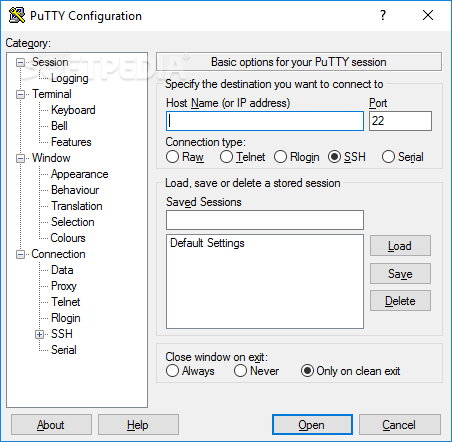

- #PUTTY SSH DOWNLOAD FILE WINDOWS HOW TO#
- #PUTTY SSH DOWNLOAD FILE WINDOWS INSTALL#
- #PUTTY SSH DOWNLOAD FILE WINDOWS FULL#
- #PUTTY SSH DOWNLOAD FILE WINDOWS SOFTWARE#
Once you are in the right directory, use the same scp command you would use for a Linux-to-Linux file transfer.
#PUTTY SSH DOWNLOAD FILE WINDOWS FULL#
The proper file path to use consists of the full Windows file path with all backslashes replaced with forward slashes, the colon after the drive letter removed, and the entire path preceded with /cygdrive/. To copy a file from a Windows computer to a Linux computer via SSH, fire up the Cygwin terminal and cd to the directory containing the file you want to transfer. $ scp -r dir and Linux-to-Windows file transfer If you want to transfer an entire directory, you add the -r option to scp like so: After I do this I go to the destination host (or do a direct SSH login) and move the file to the desired location. This is because I often don’t have the proper permissions for other directories on the destination machine such as the OpenMediaVault volume on my Raspberry Pi NAS server. When I’m transferring files through scp, my destination username will typically be the main non-root user on the destination machine and my destination directory will typically be that user’s home directory. The second argument is a specification for the destination which has the following structure:

$ scp file dissect this command now… The first argument is the file or files you want to transfer.

To copy a file from one Linux machine to another using scp, make sure an SSH server is set up on the destination host, then from the source host, type a command like this: To do a remote copy using scp, an SSH server must be running on the target machine. The name is an acronym that stands for “Secure Copy” and it is an encrypted version of the earlier “Remote Copy” program rcp. The scp command transfers files to a remote host via the SSH protocol. Cygwin comes with an SSH client installed by default, so you won’t have to do anything special here. Download the installer and then follow the installation instructions. You can get the latest version of Cygwin from the Cygwin project’s website. It is the method I use to run an SSH client from a Windows computer.
#PUTTY SSH DOWNLOAD FILE WINDOWS SOFTWARE#
I don’t actually know why.) Now you can log into your Linux system remotely from an SSH client.Ĭygwin is a program for Windows that emulates the POSIX API and command line interface, allowing you to run Unix/Linux software on Windows. (A lot of Linux systems will complain if you don’t provide the full file path for sshd. Once you’ve created an SSH host key, you can start the OpenSSH server using the following command: You can also use RSA or Diffie-Hellman, but ECDSA seems to be the de facto standard for SSH servers. I’m using ECDSA, which is a digital signature algorithm based on elliptic curve cryptography. The -t option specifies what public key cipher is to be used. The SSH daemon will not work unless you use a file in the host key format. In this command, the -A option tells ssh-keygen to create a host key file in /etc/ssh, as opposed to just a file in your home directory. You do this using the ssh-keygen command. Once OpenSSH is installed, you want to generate a host key for authenticating between the client and the server.

#PUTTY SSH DOWNLOAD FILE WINDOWS INSTALL#
OpenSSH comes preinstalled on most Linux distros, but if it isn’t, you can install it by running the package manager for your distro on the openssh-server package. Step 1: Install OpenSSH if it isn’t already installed (For Windows-to-Windows file transfer, it’s much easier to just transfer files over SMB using Windows HomeGroup.) Here are the steps needed to make seamless file transfer over a heterogeneous network a reality: Linux-to-Linux, Linux-to-Windows, and Windows-to-Linux file transfer can be accomplished with an SSH daemon running on one or more Linux hosts and/or a copy of Cygwin running on each Windows host.
#PUTTY SSH DOWNLOAD FILE WINDOWS HOW TO#
In this tutorial I want to show you how to copy files from one computer to another on a network containing both Linux and Windows hosts, using the SSH protocol.


 0 kommentar(er)
0 kommentar(er)
